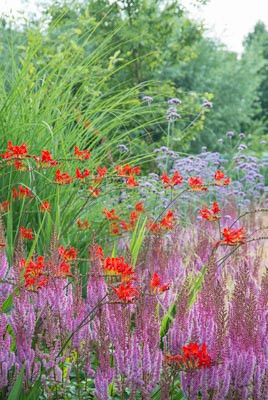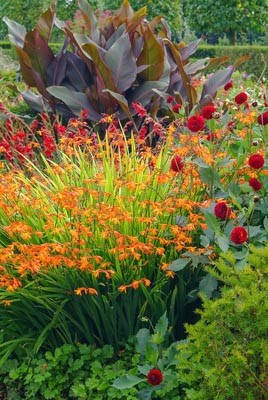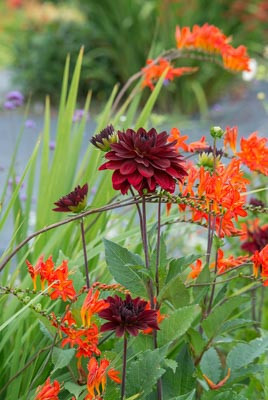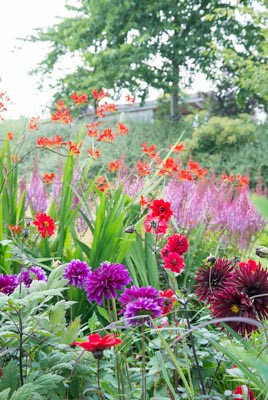Crocosmia, Montbretia, Coppertips, Falling Stars
Extremely showy and exotic-looking, Crocosmia produce decorative clumps of erect sword-shaped leaves and brilliant wands of fiery scarlet, red, orange, and yellow tubular flowers which bloom for 5-8 weeks from mid-summer through mid-fall. Magnets for hummingbirds and butterflies, the vibrant blossoms give way to seedpods that persist into fall and attract hungry birds.
Crocosmias are all bred from South African species. Reflecting intense breeding efforts, there is today a rich array of Crocosmia hybrids and cultivars to choose from. They vary in flowering times, flower color, and size. If you are unsure which Crocosmia to pick for your garden, here is a list of some of the best Crocosmia varieties.
Almost fully hardy, Crocosmias are cormous perennials that are reliable and happily multiply and come back year after year. Easy to grow, they thrive in sunny locations in well-drained, average to rich soil where they form a tight clump and produce a profusion of colorful blooms. They make lovely, lasting cut flowers and are rarely troubled by pests or diseases. Even deer don’t find them particularly appetizing.
The flamboyant colors of Crocosmias add vivid visual interest to the sunny border, and they are terrific elements in hot-colored schemes. They radiate beautifully with Heleniums (Sneezeweed), Kniphofias (Red Hot Pokers), Dahlias, and ornamental grasses, maintaining the interest well after the first leaves fall.
Their intense colors contrast well with blue and purple Salvias (Sage), Agapanthus (Lily of the Nile), Geraniums (Cranesbills), or silver foliage plants. There is a wide choice of companion plants. Alternatively, you may want to browse these planting combinations created by talented gardeners.

Crocosmia ‘Lucifer’, Astilbe ‘Purpurlanze’, Verbena bonariensis |

Crocosmia ‘Rheingold’, Canna, Dahlia |

Crocosmia ‘Lucifer’, Dahlia ‘Arabian Night’ |

Dahlia ‘Bishop of Llandaff’, Crocosmia ‘Lucifer’, Astilbe |
| Hardiness |
5 - 9 |
|---|---|
| Heat Zones |
2 - 10 |
| Climate Zones | 4, 5, 6, 7, 8, 9, 10, 11, 12, 13, 14, 15, 16, 17, 18, 19, 20, 21, 22, 23, 24, H1, H2 |
| Plant Type | Bulbs |
| Genus | Crocosmia |
| Exposure | Full Sun, Partial Sun |
| Season of Interest |
Summer (Mid, Late) Fall |
| Maintenance | Low |
| Water Needs | Low, Average |
| Soil Type | Chalk, Clay, Loam, Sand |
| Soil pH | Acid, Alkaline, Neutral |
| Soil Drainage | Moist but Well-Drained |
| Characteristics | Cut Flowers, Plant of Merit, Showy |
| Tolerance | Drought, Deer, Salt, Rabbit |
| Attracts | Birds, Butterflies, Hummingbirds |
| Landscaping Ideas | Banks And Slopes, Beds And Borders, Patio And Containers |
| Garden Styles | City and Courtyard, Coastal Garden, Informal and Cottage, Traditional Garden |
Crocosmia "Lucifer" in the garden at Overbeck's, Salcombe, Devon, ©NTPL/Andrew Butler (Nationaltrust.org)
| Hardiness |
5 - 9 |
|---|---|
| Heat Zones |
2 - 10 |
| Climate Zones | 4, 5, 6, 7, 8, 9, 10, 11, 12, 13, 14, 15, 16, 17, 18, 19, 20, 21, 22, 23, 24, H1, H2 |
| Plant Type | Bulbs |
| Genus | Crocosmia |
| Exposure | Full Sun, Partial Sun |
| Season of Interest |
Summer (Mid, Late) Fall |
| Maintenance | Low |
| Water Needs | Low, Average |
| Soil Type | Chalk, Clay, Loam, Sand |
| Soil pH | Acid, Alkaline, Neutral |
| Soil Drainage | Moist but Well-Drained |
| Characteristics | Cut Flowers, Plant of Merit, Showy |
| Tolerance | Drought, Deer, Salt, Rabbit |
| Attracts | Birds, Butterflies, Hummingbirds |
| Landscaping Ideas | Banks And Slopes, Beds And Borders, Patio And Containers |
| Garden Styles | City and Courtyard, Coastal Garden, Informal and Cottage, Traditional Garden |
Create a membership account to save your garden designs and to view them on any device.
Becoming a contributing member of Gardenia is easy and can be done in just a few minutes. If you provide us with your name, email address and the payment of a modest $25 annual membership fee, you will become a full member, enabling you to design and save up to 25 of your garden design ideas.
Join now and start creating your dream garden!
Create a membership account to save your garden designs and to view them on any device.
Becoming a contributing member of Gardenia is easy and can be done in just a few minutes. If you provide us with your name, email address and the payment of a modest $25 annual membership fee, you will become a full member, enabling you to design and save up to 25 of your garden design ideas.
Join now and start creating your dream garden!